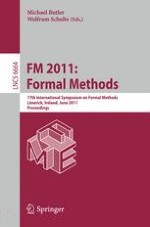This book constitutes the refereed proceedings of the 17th International Symposium on Formal Methods, FM 2011, held in Limerick, Ireland, in June 2011.
The 29 revised full papers presented together with 3 invited talks were carefully reviewed and selected from numerous submissions. The papers are organized in topical sections on cyber-physical systems, runtime analysis, case studies/tools, experience, program compilation and transformation, security, progress algebra, education, concurrency, dynamic structures, and model checking.
